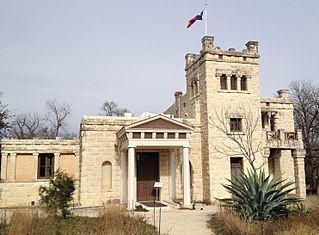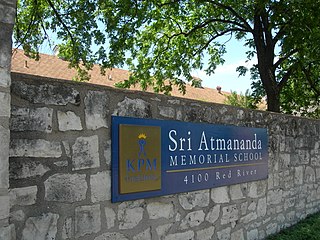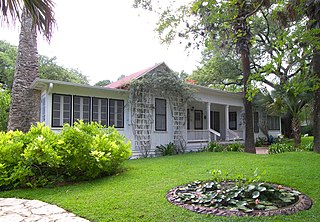
The Alamo is a historic Spanish mission and fortress compound founded in the 18th century by Roman Catholic missionaries in what is now San Antonio, Texas, United States. It was the site of the Battle of the Alamo in 1836, a pivotal event of the Texas Revolution in which American folk heroes James Bowie and Davy Crockett were killed. Today it is a museum in the Alamo Plaza Historic District and a part of the San Antonio Missions World Heritage Site.

The Daughters of the Republic of Texas (DRT) is a lineal association dedicated to perpetuating the memory of the founding families and soldiers of the Republic of Texas. The Daughters of the Republic of Texas is best known for its former role as caretakers of The Alamo. In early 2015, Texas Land Commissioner George P. Bush officially removed control of the Alamo to the Texas General Land Office. The DRT were also the custodians of the historic French Legation Museum until 2017, which is owned by the State of Texas and is now operated by the Texas Historical Commission. In addition, they operate a museum in Austin on the history of Texas.

The Wadsworth Atheneum is an art museum in Hartford, Connecticut. The Wadsworth is noted for its collections of European Baroque art, ancient Egyptian and Classical bronzes, French and American Impressionist paintings, Hudson River School landscapes, modernist masterpieces and contemporary works, as well as collections of early American furniture and decorative arts.

The Musée Rodin in Paris, France, is an art museum that was opened in 1919, primarily dedicated to the works of the French sculptor Auguste Rodin. It has two sites: the Hôtel Biron and surrounding grounds in central Paris, as well as just outside Paris at Rodin's old home, the Villa des Brillants at Meudon, Hauts-de-Seine. The collection includes 6,600 sculptures, 8,000 drawings, 8,000 old photographs and 7,000 objets d'art. The museum receives 700,000 visitors annually.
Roberta P. Crenshaw was an American civic leader and philanthropist. Crenshaw campaigned for over 60 years to preserve parkland in Austin, Texas and supported Austin-area cultural institutions.

The Umlauf Sculpture Garden & Museum, stylized as the UMLAUF, is a museum and outdoor sculpture garden centered on the artistic works of American sculptor Charles Umlauf. Located at 605 Azie Morton Road in the Zilker neighborhood of Austin, Texas, the garden is adjacent to Austin's Zilker Park.

The Elisabet Ney Museum is a museum located in Austin, Texas, United States. It is housed in the former studio of sculptor Elisabet Ney and is dedicated to showcasing her life and works. There is a permanent collection of her portrait busts and personal memorabilia on display.

The Museum of Fine Arts, Houston (MFAH), is an art museum located in the Houston Museum District of Houston, Texas. With the recent completion of an eight-year campus redevelopment project, including the opening of the Nancy and Rich Kinder Building in 2020, it is the 12th largest art museum in the world based on square feet of gallery space. The permanent collection of the museum spans more than 6,000 years of history with approximately 70,000 works from six continents.

The Austin History Center is the local history collection of the Austin Public Library and the city's historical archive.

Sri Atmananda Memorial School was a private school that for sixteen years (1995–2011) was located in a historic property north and east of the Hyde Park neighborhood of Austin, Texas. At the end it served grades K-12. Previously it only covered elementary school.

Robert William Wood was an American landscape painter. He was born in England, emigrated to the United States and rose to prominence in the 1950s with the sales of millions of his color reproductions. He was active in the art colonies of San Antonio, Texas in the 1930s, Monterey, California in the 1940s and Laguna Beach in the 1950s.

Serralves is a cultural institution located in Porto, Portugal. It includes a contemporary art museum, a park, and a villa, with each one of these being an example of contemporary architecture, Modernism, and Art Deco architecture. The museum, designed by Álvaro Siza Vieira, is now the second most visited museum in Portugal.

The Storey, formerly the Storey Institute, is a multi-purpose building located at the corner of Meeting House Lane and Castle Hill in Lancaster, Lancashire, England. Its main part is recorded in the National Heritage List for England as a designated Grade II listed building, with its back entrance being listed separately, also at Grade II.

The Contemporary Austin – Jones Center on Congress Avenue, formerly known as the AMOA-Arthouse at The Jones Center, is one of two museum sites of The Contemporary Austin.

The Mayfield–Gutsch Estate, now named Mayfield Park, is a historic cottage, gardens and nature preserve in west Austin, Texas on a bluff overlooking Lake Austin. Originally built in the 1870s, the cottage was purchased by former Texas Secretary of State Allison Mayfield in 1909. In 1922, the house passed to Mayfield's daughter, Mary Frances, and her husband, University of Texas professor Milton Gutsch. They expanded the home, adding porches on three sides and, with the help of gardener Esteban Arredondo, greatly developed 2 acres (0.81 ha) of the property around their home into a botanical garden surrounded by a rock perimeter wall. When Mary Mayfield Gutsch died in 1971, the home and grounds were left to the City of Austin for use as a park. The property was listed on the National Register of Historic Places on September 29, 1994.

The Contemporary Austin, originally known as the Austin Museum of Art, is Austin, Texas's primary contemporary art museum, consisting of two locations and an art school. The Contemporary Austin reflects the spectrum of contemporary art through exhibitions, commissions, education, and the collection. Locally, the museum is often referred to as The Contemporary.

Clara Driscoll, was a Texas-born businesswoman, philanthropist, and historic preservationist who provided the money to save the Alamo Mission in San Antonio. In 1967, a Texas Historical Marker honoring Driscoll was placed at 2312 San Gabriel Avenue, Austin. In 1978, Texas Historical Marker number 1287 honoring Driscoll was placed at the Driscoll Family Mausoleum, Alamo Masonic Cemetery, East Commerce St., San Antonio.

Arrowmont School of Arts and Crafts is an Arts and Crafts center in the U.S. city of Gatlinburg, Tennessee. The oldest craft school in Tennessee, Arrowmont offers workshops in arts and crafts such as painting, woodworking, drawing, glass, photography, basket weaving, ceramics, fiber arts, book arts and metalworking. The School has an 11-month Artists-in-Residence program for early career artists. Arrowmont's campus contains the oldest buildings in Gatlinburg and comprises two historic districts listed on the National Register of Historic Places.
Michael Frary was an American Modernist artist from Santa Monica, California, who was known for his interest in structural forms and architectural compositions, as well as for his Surrealist impulses. A versatile artist, Frary experimented with a range of mediums and constantly refined his approach to his subjects.
Annette DiMeo Carlozzi is an American curator of contemporary art based in Austin, Texas. Raised in suburban Boston, she graduated from Brandeis University in 1975 with a BA degree in Art History, magna cum laude, studying with Professors Carl Belz, Gerald Bernstein, and Stephen Whitfield. A first-generation college student, she received a full scholarship to and attended the MA program in Museum Studies at the University of Minnesota. From 1976 to 1978, Carlozzi began her professional training as a Curatorial/Education Fellow at Walker Art Center in Minneapolis under the mentorship of Director Martin Friedman.

















